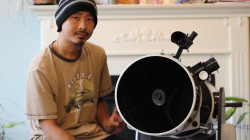I will show you how to clean my telescope eyepieces in this episode. And while eyepieces are generally maintenance-free, it’s good practice to keep your eyepieces clean. Over time, the oils on our skin will make the housing of our eyepieces sticky and this can attract dirt. Oils can also get on the lens which makes for a blurry view.
Here are the tools I will use in this video:
Squeeze bulb air blower
- Brush: http://amzn.to/2Cgd0dB
- Cotton swabs
- Microfibre cloth
- Alcohol
- Lenspen lens cleaner: http://amzn.to/2Cgd0dB
Pocket Sky Atlas: http://amzn.to/2BZUUzG
Sky Maps: http://www.skymaps.com/downloads.html







